|
1.
CENTRAL/ WEST AFRICA
Indian importers take lead in log trading
Buyers for the Indian market remain very active and are prepared to pay higher prices for the species they want.
Buyers for China have to meet this price competition and pay the increased prices. Okan has once again showed a
substantial gain, with both LM and B grades rising by $45 per m3 for Europe and a further $45-60 per m3 for
Asian destinations. Okan is being featured for the first time in the MIS Report.
Policy on concession permit fees showing results
In Cameroon, some of the major producers have renewed applications for permits for concession areas even though
permit costs have been significantly raised under the new government policy to increase State revenues from forest
based activities. The policy also intends to put pressure on operators to move into further processing instead of
only log exporting. This has been successful, leading to production of window frames and other kiln-dried
joinery components. Export logs from Central African Republic are much reduced because of tighter control at
the Cameroon border and high transport costs, while sawn lumber exports are fairly stable.
Asian demand keeps Gabonese traders busy
Gabonese log exporters remain busy with a number of species for China and India plus the usual strong and growing demand for okoume and ozigo. The SNBG continues the State monopoly on exports of okoume and ozigo, which has kept prices steady to the relief of many exporters who had feared a price war. Government proposals for a new log quota system and other controls have been postponed until July to give time for companies to reorganize and establish the required down-stream processing facilities.
Lumber prices unchanged despite strong demand
Lumber prices are unchanged through February, though demand is reported as strong. Sapele stocks in the main consumer markets are much reduced and buyers are already making replacement purchases. Demand is also picking up for makore and sipo, with exporters expecting higher prices as supply from Northern Republic of Congo begins to dip as the rainy season starts. Planed and processed azobe and some of the red species are in demand for Europe. Moreover, some garden furniture and other manufactured products are beginning to
challenge the Far East producers who had held a virtual monopoly of these products previously, following the lead of Ghana which has already a substantial presence in downstream processing for exports.
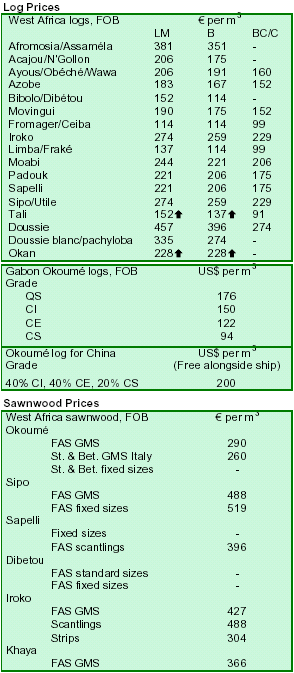
2. GHANA
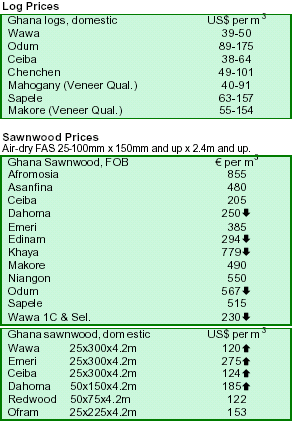
3.
MALAYSIA
Exchange for wood-based products in the cards
Malaysia's may soon see the introduction of a new commodity product for investors via a derivative exchange for wood-based products, according to Gaya Tunas Sdn Bhd's consultant Datuk Dr. Baharuddin Ghazali.
Gaya Tunas was appointed by the Malaysian Timber Industry Board (MTIB) to elaborate the country's first National Timber Industry Policy (Natip). Dr. Baharuddin said the exchange would be a central meeting place to transact futures contracts for timber products. The new
derivative product will complement the crude palm oil (CPO) and palm kernel oil futures contracts which are already actively traded in the Bursa Malaysia Derivatives Exchange Bhd.
The recommendation on the wood-based derivatives exchange is one of Gaya Tunas?proposals for the policy to boost the sector's global competitiveness. The Minister of Plantation Industries and Commodities Datuk Peter Chin Fah Kui is expected to submit the Natib
to the Cabinet for approval this year.
Timber exports climbed to 21.5 billion MR in 2005
Malaysia registered a trade surplus of 99.8 billion Malaysian ringgit (MR) in 2005 as exports grew 11% to 533.8 billion MR and imports rose 8.5% to 434 billion MR, according to the Malaysian Statistics Department.
Timber and timber-based products were the fourth largest export earner with 21.5 billion MR or 4% of total exports (up 8.5% percent from 2004). Electrical and electronic products (50% of total exports), crude petroleum (5.5%), palm oil and palm oil-based products (5.3%) were the other leading export earners.
lIlegal logs seized from a sawmill
Sarawak Forestry's (SF) enforcement officers raided a sawmill in Lawas for processing illegal logs valued at almost 2 million MR ($535,618). The raid involved the seizure of more than 1,900 pieces of logs, 651 bundles of sawn timber, 8 bandsaws, 4 forklifts, 3 shovels, 16 trolleys and 3 generators, as well as the detention of 20 workers.
Under the Sarawak'S Forest Ordinance, SF forest officers are empowered to seize any forest produce, together with equipment or property used in committing an offence.
Facing competition by value adding
The Export Furniture Exhibition (EFE) is scheduled to open on 6 March at the Asia Pacific Auction Centre (APAC) Exhibition Hall in Subang, Selangor. The five-day event will attract some 200 furniture manufacturers showcasing their latest products and is expected to bring over 15,000 visitors.
The exhibition is organized by the Malaysia Furniture
Entrepreneur Association (MFEA), which represents all 13 state furniture associations in the country. The event'S chairman, Quek Kheng Long said that with stiff competition from China and Vietnam, which can offer products at low prices, the sector had to invest heavily in design and quality to attract international buyers. Mr. Quek said local manufacturers should not aim at lowering their prices which would compromise quality, but at capitalizing on the country'S rich rubberwood resource and enhancing product value.
Mr. Quek added that the sector did not regard China and Vietnam as a threat as the local industry had its own strengths. "we just need to optimi ze it" he said.
MTCC registers first overseas-based assessor
MTCC has recently approved the registration of Denmark's NEPCon (Nature, Ecology and People
Consult) as the first overseas -based independent assessor for chain-of-custody certification.
A total of 83 timber companies have been awarded the MTCC Certificate for Chain-of-Custody while exports of MTCC-certified timber products have increased to more destinations in Europe. About 55,400 m3 of MTCC-certified sawn timber, mouldings, laminated finger-jointed timber and plywood were exported to The Netherlands, Belgium, Germany, the UK, France,
Australia, Greece, Denmark, Poland and Italy in 2005. MTCC-certified sawn timber has been exported to Denmark since August 2005.
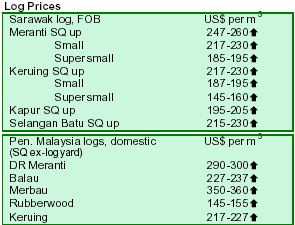
Peninsular Malaysian meranti logs are top grade and are used for
scantlings for the EU. Their prices are higher than Sarawak¡¯s.
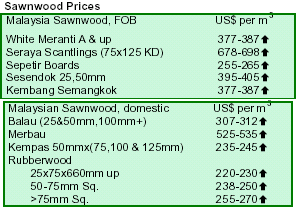
4.
INDONESIA
Indonesian customs seize illegal timber shipments
Indonesian customs officials have recently seized 20 ships, 8 of which were carrying 613,000 m3 of illegal wood worth $376,344 in Riau Islands province, in Sumatra, south of Singapore. The ships had allegedly been attempting to smuggle their cargo into neighbouring countries. Customs officials admit that illegal timber smuggling is difficult to thwart in the province.
Government relaxes sawnwood export ban
Trade Minister Mari Elka Pangestu has issued a new regulation allowing wood producers to export certain types of sawnwood to revive the struggling wood-based industry. The new regulation will become effective on 3 March 2006.
The ruling replaces two 2004 Ministerial decrees jointly issued by the Forestry Ministry and the Trade Ministry, which banned the export of all types of sawnwood to help conserve the country's forests and promote value adding.
Under the new regulation, exporters are required to get approval from the Forestry Industry Revitalization Agency. Also under the new regulation, the Trade Ministry will strictly supervise the export of 32 wood-based products including veneer, plywood and panels. Only registered exporters would be allowed to export these products.
EU proposes collaborative FLEGT scheme
The EU is proposing a collaborative scheme with the Indonesian government to allow its members to inspect wood-based imports from Indonesia, such as plywood and wood panels, as part of EC-Indonesia Forest Law Enforcement, Governance and Trade (EC-FLEGT).
The EU's Natural Resources Programme Manager for Indonesia, Vernon Copeland, informed that the EU hoped to reach an agreement on the matter with the Indonesian government by the end of this year or early next year.
Under the scheme, Indonesia will be required to issue documents providing evidence of the legality of exported panels. The customs and excise services of the individual EU members would then inspect the documents and confiscate any panels found to be illegal. Mr. Copeland
estimated Indonesia's share of the EU panel imports market at less than 10%.
However, Mr. Copeland clarified that the scheme would be applied on a voluntary basis, and that no sanctions would be imposed against EU member states that allowed the entry of illegal timber products.
The European Commission (EC) has disbursed about €1 million in grant to fund the operation of the Illegal Logging Response Centers in Indonesia (see MIS 11/3). The EC is due to disburse another
euro15 million in March 2005.
Red Cross seeks timber out of Aceh for rebuilding
A timber shortage has slowed down a Red Cross project to build shelters for 60,000 Indonesian survivors of the Asian tsunami in Aceh province. So far only 800 people
have been housed because of a lack of wood meeting Red Cross environmental standards, according to the province's Reconstruction and Rehabilitation Agency (BRR).
The BRR has banned the use of wood logged in Aceh for environmental reasons, so timber has been imported from other countries, including Canada and New Zealand. Two international tenders failed to find an acceptable supplier. The Red Cross now hopes that a UK-based
timber agent can provide 10,000-35,000 m3 of Canadian wood for the project.
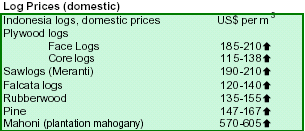
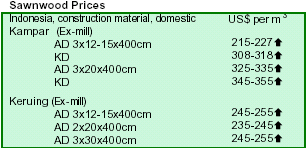
5.
MYANMAR
Further rise in MTE teak prices
With its fiscal year coming to a close at the end of March, MTE raised the prices for direct sales of teak logs for the second time in February. Direct sales prices are at (US$ per hoppus ton FOB Yangon) $1,270-$1,697 for SG-4 grade, $999-$1,162 for SG-5 and $814-$890 for
SG-6, depending on the source region.
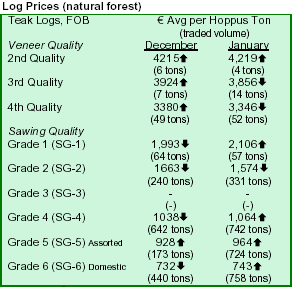
Hoppus ton=1.8m3; All grades, except SG-3, assorted and domestic, are length 8¡¯ x
girth 5¡¯ and up. SG-3 is girth 4¡¯ and up while assorted and domestic are girth 4¡¯ and up.
SG-3 grade is higher than SG- 4 but with lower girth and price.
Pyinkado prices also raised
On 17 February there was another MTE price increase for pyinkado logs. New pyinkado prices (US$ per Hoppus ton, FOB Yangon) are at $480 (East Bago area), $470 (West Bago area) and $450 (other areas). Pyinkado continues to perform better than gurjan. But generally,
hardwood market conditions remain the same as in previous weeks.
6. PAPUA
NEW GUINEA
PNG log exports surge 17% to $138.6 million
Log exports from PNG amounted to 195,511 m3 (US$12.31 million) in December, bringing total log exports to 2.28 million m3 ($138.6 million) in 2005. These figures were up 13.4% in volume and 16.5% in value from 2004. Saw/veneer grades accounted for 84% of the log exports. Main log export species were malas, taun, bintangor and terminalia. China took 75% of all log exports, followed by Japan (9.5%), Vietnam (6.4%) and Korea (5%). Of the saw/veneer log grades, China imported 84%, Japan 7.7%, Korea 3.4% and Vietnam 1.6%. For plantation species, kamarere remained the main export species primarily to the markets of Vietnam, Japan, China and Korea.

7.
BRAZIL
Currency factors drive domestic prices up
Domestic wood products prices increased on average 0.9% in Brazilian real (BR) and 5.6% in US dollars due to the continued appreciation of the Brazilian currency.
Brazilian forest product exports up 4.7%
Brazil's exports of forest products rose to $871.6 billion in 2005, up 4.7% from 2004. The rise was due primarily to price increases of some lumber species, greater value adding and diversion from domestic to export markets. These factors partially offset the sharp reduction in raw-material supply that resulted from unapproved forest
management projects.
Export earnings could have been higher if not for the strengthening of the Brazilian Real (BR) against the US dollar. The sharp appreciation of the BR in 2005 has affected the competitiveness of many exporting segments, including the forest sector, whose operational
margins and capacity of investment have been gradually reduced. This situation has prompted exporting companies to cut production costs to remain competitive in the international market.
Brazil's economic growth slows down
Economic growth in Brazil slowed in the third and again in the fourth trimester of 2005. Four quarter GDP data shows that the economy expanded by 0.8%, failing to offset a 0.9% decline in the third quarter. Overall in 2005, growth slowed to 2.3% after the economy
expanded 4.9% in 2004. Brazil¡¯s agricultural sector had its worst year since 1997 with output increasing by only 0.8%, although the industrial and services sectors expanded by 2.5% and 2%, respectively..
Deforestation slows down in the Amazon
The deforestation rate in the nine Brazilian Amazon States declined by over 31% in 2005. The decline was particularly significant in Mato Grosso, which rate fell by about 41%. The deforestation rate in
Para and Rondoia fell by 28% and 18%, respectively.
One of the main concerns of the Ministry of the
Environment is that deforestation could shift from one place to another in the region due to ongoing controls. The federal government has a budget of 400 million BR up to 2007 for combating deforestation in the Brazilian Amazon. The budget is distributed among the 13
Ministries that take part in the programme .
Brazil establishes 6.6 million ha of conservation areas
The federal government established more than 6.4 million ha of Conservation Units (UCs) in the Amazon State of Par?in early February 2006. Out of this total, 1.6 million ha are under full protection (two National Parks and the enlargement of the Amazon National Park) and
4.8 million ha will be subject to sustainable use (four National Forests and one Environment Protection Area).
The new Conservation Units are part of the First Sustainable Forest District (SFD) of Brazil, created by law decree, encompassing 16 million ha from which 5 million ha will be set aside for Sustainable Forest Management (SFM). The District is intended to stimulate
the technological development of the forest sector and to attract new investments. The federal government expects that the District will create 100,000 new jobs and generate 4 to 6 million m?of logs per year, beside producing 200 to 800 MW of energy, without degrading
the forests.
Analysts think that the creation of a SFD in Para is a positive measure to support regional lumber production. However, the participation of State Governments in this project is not clear as they have to create their own State Production Forests in order to establish their own forest concessions.
Marginal increase in wood utilization rate
Small entrepreneurs in the Brazilian Amazon have increased slightly the utilization of forest wood residues in the production of commercial wood products, such as furniture and woodworking. The reduction and utilisation of wood waste is an essential aspect to ease the demand for wooden raw material and, consequently, the pressure on natural forests.
According to Imazon (Amazon Institute of the People and the Environment), Amazon sawmills consumed about 24.5 million m?of sawlogs in 2004, but only 10.4 million m?were traded. This indicates that the rate of wood utilisation by the small industry was only 42%,
while the remainder was wasted, transformed into sawdust or wood pieces too small for the market. The problem, according to Imazon, is due to the lack of planning and training of operators (some of them illegal), use of old equipment and deficient infrastructure. With
no adequate installations, the wood is usually left exposed to sun, rain and bugs.
However, the rate of wood utilisation by the sector was only 38% in 1998. The rise of the rate from 38% to 42% means that about 950,000 less trees were harvested in 2004. Estimates suggest that if the rate goes up 45%, it would be possible to save other 400,000 trees per year.
PEIEX strengthens timber export companies
About 252 solid-wood companies in more than nine cities in Sinop, an important wood-producing cluster in Northern Mato Grosso in the Brazilian Amazonia, will benefit from the new Programme of Industrial Export Extension (PEIEX).
The program was jointly developed by the Ministry of Development, Industry and Foreign Affairs (MDIC) and the Secretary of State of Industry, Commerce, Mines and Energy. PEIEX¡¯s budget is 800,000 BR and aims at identifying companies¡¯ barriers for industrial production,
administration and labour. A diagnosis of the companies will strengthen their access to foreign markets. According to Sinop¡¯s authorities, the city¡¯s export earnings dropped 11 million BR in 2005, causing an economic crisis.
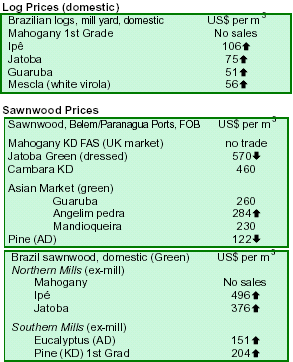
8. PERU
Peruvian exports jumped to $168 million in 2005
Latest statistics show that Peruvian exports of timber and timber products reached $168.3 million in 2005, up 28% from 2004 but below the projected $180 million.
Analysts cite some factors that prevented greater exports, including problems faced by the forest concessions (see MIS Report 10/20); delays in the approval of Forest Management and Annual Operation Plans; and the ongoing crackdown on illegal logging that has reduced
the availability of raw materials.
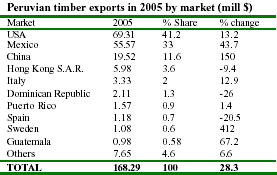
Export markets increased from 66 countries in 2004 to 76 in 2005. The USA remained Peru¡¯s major trading partner (41% of exp orts), followed by Mexico (33%) and China
(12%, excluding Hong Kong S.A.R.). China (third export market) and Sweeden (ninth) are the fastest growing export markets. The composition of exports has varied significantly in recent years. From 2000 to 2003, exports were led by raw materials (notably mahogany and virola sawnwood) but in 2005, exports of further processed products, such as mouldings and friezes (up 87% from 2004), other wooden furniture (up 222%), veneer (up 60%) and plywood (up 33%), became increasingly important. However, sawnwood still accounts for 34% of
the exports in 2005.
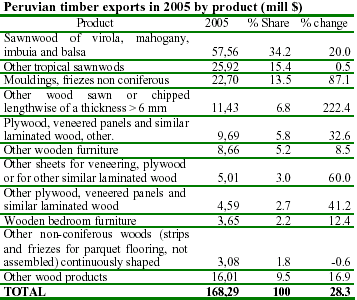
USA continued to absorb most of the Peruvian mahogany products (mainly sawnwood), importing 92% of the $35.4 million (88% of the 23,649 m3) total mahogany product exports in 2005. Exports to Mexico were mainly virola sawnwood, plywood and Spanish cedar. China
imported mainly wooden friezes of cabre uva, cumaru, manilkara and jatoba.
Callao remained the largest export port, accounting for 83% of the timber exports, followed by Iquitos (16%). Timber comprised 99.5% of Iquitos total exports, which go mainly to the markets of Mexico and the USA.
Joint Peru-Brazil mechanisms in the Amazon
Brazil¡¯s Minister of Environment, Marina Silva Souza and the head of the Environmental Committee in Peru, Carlos Loret de Mola agreed to implement joint mechanisms to protect the Amazon of both countries, which together account for 81% of the continent's Amazon forest. The announcement was made during the VI National Eco Dialogue and First Amazonian Dialogue
held on 24 February in Iquitos, Peru.
Minister Silva also urged both governments to protect the forest areas surrounding the Inter-Oceanic road that will link both countries.
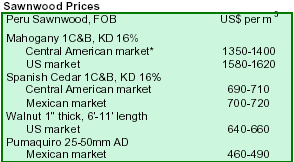
*Cheaper and small-dimension sawnwood for
this market.
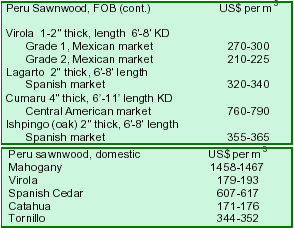
9. BOLIVIA
Wood products exports surge 15% in 2005
Bolivian wood products exports reached $78.6 million in 2004, with the cities of Santa Cruz and La Paz accounting for 71% of the total exports. Based on preliminary statistics, the Bolivian Forestry Chamber estimates that wood exports surged to about $90 million
in 2005, up 15% from 2004.
Business roundtable of the wood industry
Bolivia¡¯s Forestry Chamber, Santa Cruz's Industry and Service Providers Chamber (Cainco) and FexpoCruz are organizing the Second Business Roundtable of Bolivia's wood industry on 23-24 March. The event will take place during the EXPOFOREST 2006, Bolivia's forestry sector most important trade show. More information available at http://www.cfb.org.bo/CFBInicio/fraFeriasEng.htm.
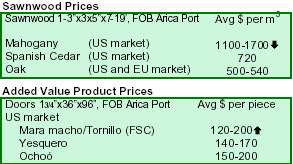
10. Guatemala
India is Guatemala's largest teak importer
Guatemala exported 3,018 m?of teak logs and sawnwood (worth $661,650) in 2005, accounting for 1% of Guatemala's total wood exports. India was the largest importer of teak products, taking up 70% of the exports. In January 2006 alone, India imported 100% of the teak
product exports.

11.
Guyana
Logs in short supply
Roundwoods remain in short supply as a result of the recent extended rainy season. This has also affected plywood production. However, the sawnwood market remains very active and prices are gradually increasing. There is increased interest from European, Canadian and
Asian buyers. The Caribbean market is also picking up after slowing down during the Christmas season.
FPMC reports first certified FMU in Guyana
According to Guyana¡¯s Forest Products Marketing Council (FPMC), a large forest management unit (FMU) has recently been FSC certified, paving the way for the export of certified wood products. FPMC expects that this development would generate additional interest
especially in environmentally sensitive markets.
The FPMC, in collaboration with the Guyana Forestry
Commission and the Forestry Training Center Inc., is embarking on the development of a Legal Verification Scheme for Guyana to allow buyers to verify the legality and origin of Guyanese wood products.
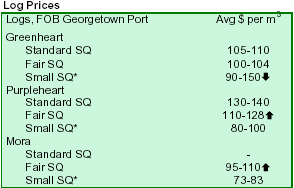
*Small SQ is used for piling in the USA and EU. Price depends on length.

|